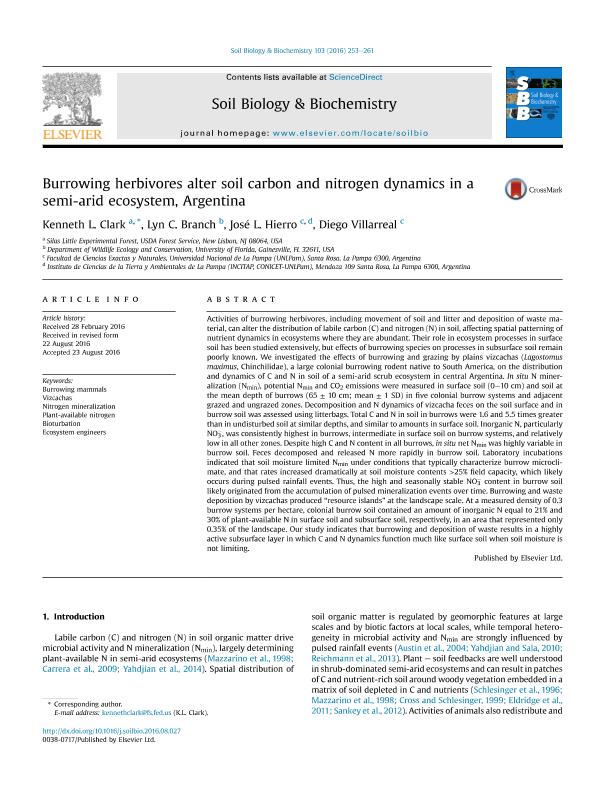Artículo
Burrowing herbivores alter soil carbon and nitrogen dynamics in a semi-arid ecosystem, Argentina
Fecha de publicación:
12/2016
Editorial:
Elsevier
Revista:
Soil Biology And Biochemistry
ISSN:
0038-0717
Idioma:
Inglés
Tipo de recurso:
Artículo publicado
Clasificación temática:
Resumen
Activities of burrowing herbivores, including movement of soil and litter and deposition of waste material, can alter the distribution of labile carbon (C) and nitrogen (N) in soil, affecting spatial patterning of nutrient dynamics in ecosystems where they are abundant. Their role in ecosystem processes in surface soil has been studied extensively, but effects of burrowing species on processes in subsurface soil remain poorly known. We investigated the effects of burrowing and grazing by plains vizcachas (Lagostomus maximus, Chinchilidae), a large colonial burrowing rodent native to South America, on the distribution and dynamics of C and N in soil of a semi-arid scrub ecosystem in central Argentina. In situ N mineralization (Nmin), potential Nmin and CO2 emissions were measured in surface soil (0–10 cm) and soil at the mean depth of burrows (65 ± 10 cm; mean ± 1 SD) in five colonial burrow systems and adjacent grazed and ungrazed zones. Decomposition and N dynamics of vizcacha feces on the soil surface and in burrow soil was assessed using litterbags. Total C and N in soil in burrows were 1.6 and 5.5 times greater than in undisturbed soil at similar depths, and similar to amounts in surface soil. Inorganic N, particularly NO3−, was consistently highest in burrows, intermediate in surface soil on burrow systems, and relatively low in all other zones. Despite high C and N content in all burrows, in situ net Nmin was highly variable in burrow soil. Feces decomposed and released N more rapidly in burrow soil. Laboratory incubations indicated that soil moisture limited Nmin under conditions that typically characterize burrow microclimate, and that rates increased dramatically at soil moisture contents >25% field capacity, which likely occurs during pulsed rainfall events. Thus, the high and seasonally stable NO3− content in burrow soil likely originated from the accumulation of pulsed mineralization events over time. Burrowing and waste deposition by vizcachas produced “resource islands” at the landscape scale. At a measured density of 0.3 burrow systems per hectare, colonial burrow soil contained an amount of inorganic N equal to 21% and 30% of plant-available N in surface soil and subsurface soil, respectively, in an area that represented only 0.35% of the landscape. Our study indicates that burrowing and deposition of waste results in a highly active subsurface layer in which C and N dynamics function much like surface soil when soil moisture is not limiting.
Archivos asociados
Licencia
Identificadores
Colecciones
Articulos(INCITAP)
Articulos de INST.D/CS D/L/TIERRA Y AMBIENTALES D/L/PAMPA
Articulos de INST.D/CS D/L/TIERRA Y AMBIENTALES D/L/PAMPA
Citación
Clark, Kenneth L.; Branch, Lyn Clarke; Hierro, Jose Luis; Villarreal, Diego; Burrowing herbivores alter soil carbon and nitrogen dynamics in a semi-arid ecosystem, Argentina; Elsevier; Soil Biology And Biochemistry; 103; 12-2016; 253-261
Compartir
Altmétricas




